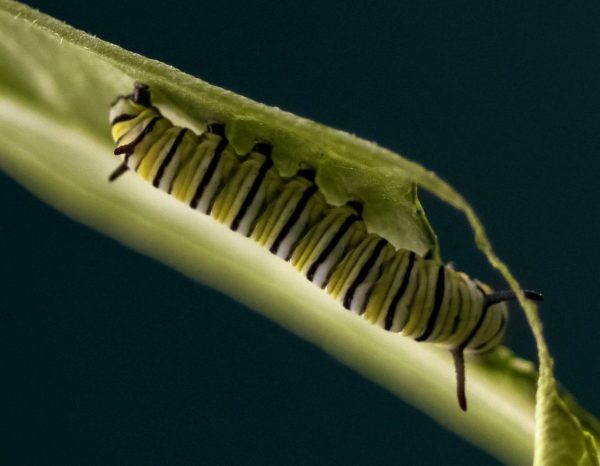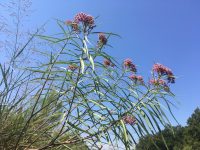With a decision on whether or not the monarch butterfly will be listed as “threatened” under the Endangered Species Act due by December 15, a new study challenges the conventional narrative that the migrating monarch butterfly population is in decline.

Andy Davis, Courtesy photo
Migration studies expert Andy Davis, a professor at the Odum School of Ecology at the University of Georgia and editor of the Migration Studies Journal, published the paper on his Monarch Science blog on October 28. Davis is married to monarch butterfly disease expert and Odum School of Ecology professor Sonia Alitzer.
Davis’ paper, titled A Review of Published and Unpublished Findings from 20 Long-term Monitoring Studies of Eastern Monarch Butterflies: the Population was Never in Danger, Despite Recent Winter Colony Declines, awaits peer review.
It examines 20 previously published data sets from multiple decades, including the population counts from the winter roosting colonies.
“Modest declines are evident in the winter colonies” and in several spring recolonization data sets, Davis states on page one of the paper. But, he writes, 16 separate studies conducted during the summer and fall “revealed either no trend at all, or in fact an increase in abundance.”
Davis goes on to challenge what he labels the “dogmatic narrative” of monarch butterfly decline.
Specifically, he rejects the decades-long fixation on the Mexican overwintering sites as prime indicator of monarch population health. That, and misguided concerns about a lack of milkweed, the monarch butterfly’s singular host plant, bring him to the conclusion that “the eastern North American monarch population is doing just fine.”
“Monarchs in eastern North American are capable of rebounding fully each year, implying that milkweed is not limiting within their range,” writes Davis of what’s known in monarch circles as the “milkweed limitation hypothesis.”
He contends that while modest declines in the overwintering populations are evident, monarchs may be more resilient than other insect species whose populations are crashing during a time that has been called the insect apocalypse–a storm of climate change, pesticide abuse and habitat destruction.
Monarchs are capable of utilizing a variety of human altered landscapes, says Davis. “It should not be overlooked that milkweed thrive in disturbed landscapes,” he states on page 16 of the study. He notes that monarch abundance is inversely associated with forest area.
“Any forest clearing for human activities, while destructive, can in fact benefit monarchs,” says Davis.

Davis argues that the eastern North American monarch population is “doing just fine.” Photo by Walley Films
He also suggests that the size of the winter colonies doesn’t matter because monarchs have the capacity to rebound throughout the season. Environmental conditions during the spring and summer are much more important, he states.
These challenges to existing conventional wisdom on the state of monarch butterflies caused mixed reactions throughout the monarch butterfly community.
“I think it is near indisputable that monarch butterflies have declined considerably since the late 1990s,” said Wayne Thogmartin, a Quantitative Ecologist at United States Geological Survey who has authored and co-authored several studies on monarch butterfly decline.
Anurag Agrawal, chemical ecologist at Cornell University and author of Milkweed and Monarchs, agreed with Davis that milkweed availability is not the primary challenge to monarch butterfly health. Agrawal authored a controversial study in 2016 that cast a lack of milkweed as an “unlikely” driving force behind monarch’s population decline.
“I am now more convinced than ever,” said Agrawal via email in response to the Davis paper. “All the data are essentially correct. And it is time for the deniers…to embrace the full annual cycle data. Andy’s paper convinces me of that.”

According to Andy Davis, plenty of milkweed exists to fuel the monarch butterfly population. Photo by Monika Maeckle
Chip Taylor, founder of Monarch Watch, and one of the most vocal and public proponents of the “milkweed limitation hypothesis” as an explanation for monarchs’ decline, disagrees.
“To anyone who doubts that monarchs are in decline, I would suggest they look at the data just as I would advise those who doubt climate change,” Taylor said. He added that the loss of monarch habitat over the years has been well documented. “The importance of habitat vs. migration mortality was the basis for our most recent paper,” he said.
Weighing in from Emory University, biologist Jaap de Roode found the Davis paper compelling and convincing.
“Monarchs are doing relatively well,” said de Roode, who has another study currently being peered reviewed, but referenced in Davis’ paper.
“This is not a cynical finding or a cue to give up on anything….It’s more a sigh of relief and pointing more accurately to where the problem is–that it’s harder for the monarchs to migrate to Mexico.”
The de Roode study that Davis references compares genetic diversity in museum samples of monarchs from 1977 to modern specimens. It found no decline in genetic diversity in the last 40+ years. In fact, genetic diversity in monarch butterflies may have even increased.
Almost every scientist interviewed for this article pointed out that the Davis study awaits peer review, which could affect its final publication. But as one pointed out, the Davis study is a review of previously published work–all of which have already undergone peer review.
“It’s worth noting that the vast majority of other peer-reviewed studies looking at population trends for the eastern population have chosen to not use this data,” said Emma Pelton, a scientist for the invertebrate conservation organization the Xerces Society, referring to Davis’ treatment of older data. She added that those estimates were collected before systematic colony surveys began in 1993-94.
Xerces is one of several parties that filed the Endangered Species listing back in 2014.
As for the impact the Davis study might have on that ESA listing, due within a month, most scientists said they didn’t believe the paper would have any effect.
Citizens scientists and monarch butterfly aficionados felt their heads spinning. For the last half decade, they have generously supported fundraising pleas and the planting of milkweed. The Mexican overwintering population counts, announced in early spring, often set the tone for the season and are met by media and monarch followers with great fanfare and authority.
“Just now read the lengthy blog,” noted Kay Henrichs on Facebook. “Very interesting and certainly going against everything I have read and know about the monarch population!! Illinois has a monarch action plan to plant millions of milkweed seeds and plugs in the next few years!!!!”
The impact on monarch conservation remains to be seen. If the insects are truly so resilient, then how will monarch butterfly supporters respond to fundraising pleas to “save the monarch butterfly”?
“I had some hopes that if this finding is true, that monarch populations are only crashing in Mexico, that this news could translate into more attention, research and resources for their overwintering habitat,” said Ellen Sharp, owner of J&M Butterfly B&B in Macheros, Mexico.
Sharp and her partner Joel Moreno founded their B&B at the trailhead of Cerro Pelón, one of the sites where the monarchs roost each winter. They also started a nonprofit, Butterflies and their People, to help guard the forest. Until recently, they also organized ecotourism outings to the roosting sites, which are now closed because of COVID-19.
“I am concerned about the implications of this finding because I’m sure all the funding and conservation efforts on behalf of this charismatic flagship species are benefiting the rest of the ecosystem,” said Sharp.
Related Articles
- Q&A: Migration expert Andy Davis says for monarchs it’s survival of the biggest
- Happy 50th Earth Day: Monarch butterflies enjoy a win of sorts
- Endangered Species Act: wrong tool for monarch butterfly conservation?
- USFWS gets three more years to evaluate monarch butterfly ESA status
- Founder of the monarch butterfly roosting sites lives a quiet life in Austin, Texas
- Entry to Mexico’s most popular monarch butterfly preserve should cost more than $2.77
- How to plan a successful butterfly garden
- What will happen to pollinator advocacy under President Donald Trump?


I do agree that we should be looking at the year-round numbers of the monarch butterfly, not just relying on the over-wintering numbers. Many butterflies are over-wintering where people are not. And I recommend that they do just that.
I quietly visited an over-wintering site in California in December a few years ago. It was a lovely visit, and the knowledgeable docents pointed out that a few butterflies were still arriving.
I should say it was a lovely visit until. A big smelly bus pulled up. I couldn’t tolerate the diesel fumes, so I left – feeling sorry for the butterflies. I don’t blame them if some found a new site. Sadly, many of these sites are becoming tourist attractions, and the butterflies go elsewhere. Scientifically speaking, it makes more sense to observe them throughout the life-cycle.
I do not think that the monarch butterfly should be on the threatened list at this point. The species does not meet the criteria, and there are many species that do meet the criteria. Still, I do applaud anyone who cares about our environment and takes steps to conserve habitat for all animals, not just the monarch butterfly. I think we all need to be mindful towards this goal.
The camp of scientists who believe in the: “it’s become harder for the monarchs to migrate to Mexico” hypothesis can’t tell us why that might be so. That’s because they do not periodically visit various locations along the Central Flyway in Sept/Oct/ to view and photo document whether or not adverse changes are occurring in the landscape.
Same situation with many other issues. Example: does migration truly “weed out” smaller sized fall migrants or those with high OE spore counts? We will not know for sure until the camp of scientists who have been proposing those effects actually start visiting various locations along the Central Flyway in Sept/Oct to catch large smaples of fall migrants from overnight roosts to measure their wing sizes and OE spore counts.
Good thoughts, Paul,
Backyard scientists are reporting on the migration as the butterflies make their way south. Are the butterflies congregating along the southern portions of Texas – and not making the leap? Are there more butterflies – or the same or fewer – in the Flyway, compared to previous years?
Interesting questions. So many butterflies, so little time. 🙂
A couple more thoughts:
1) This quote jumped out at me “Monarchs are capable of utilizing a variety of human altered landscapes.” So true. Indeed, I recall learning that the migration in the eastern United States did not happen until humans cut down forests. Also, in the western United States monarch butterflies did not over-winter in eucalyptus trees until humans started planting them a hundred years ago or so.
2) Nevertheless, I do believe that the efforts of gardeners and commercial growers have contributed to an increase in milkweed in the last five years. I am reminded that earlier this year, historic agreements have been signed by landowners to dedicate a portion of their land to monarch conservation. I do think there WAS in fact a decline in milkweed – but many concerned people have filled that gap. And I do think we all will continue to do so, because clearly those efforts are working.
3) Yes, it is possible that fewer monarch butterflies are migrating to Mexico. Versus simply finding another area there that is more peacefully located – and thus are not included in the counts. Still, many species are making smaller migrations, it is a reality of our world. Given a choice between clumping in 40 degree weather or flying around in 70 degree weather, well, I know what choice I would make!! On a serious note, it would be interesting to know what percent of the summertime monarch population descended from the migratory population and what percent have non-migratory ancestors. Since we are seeing an increase in the summertime butterflies, I think that enough do migrate to ensure the strength and health of the species.
Keep up the good work, everyone!! We made a difference, and we will continue to do so.
I would be surprised if Trumps director of Fish and Wildlife will list the monarch although I’m surprised everyday. The weather conditions and how it varies throughout the eastern range during any given season determines the amount of viable habitat, predator numbers, and therefore the monarch numbers that make it to Mexico. The most glaring proof of that fact is demonstrated at the following link which demonstrates why the 2013-14 Mexican numbers were lowest in 25 years. https://en.wikipedia.org/wiki/2010%E2%80%932013_Southern_United_States_and_Mexico_drought#:~:text=The%202010%E2%80%932013%20Southern%20United,Kansas%2C%20Colorado%2C%20New%20Mexico%2C
The 2010-13 drought is the only devastating drought on the eastern range since numbers have been counted. The six hectare count year before last demonstrates when weather conditions are right on the eastern range there’s plenty of habitat for that number of monarchs considered a sustainable number for the migration. Sure gmo and roundup had some affect but not much, monarchs have adjusted. The people who make the very secretive and “not” audited counts changed about the time the yearly averages declined. Those new counters get more contributions when numbers are low. However, the fact remains, the best thing we can do for the entire wildlife food chain throughout North American is plant pollinator habitat from sea to shining sea on every square inch of land possible including at least half our yards.